 Figure 1. The
Lower Columbia Slough.
Figure 1. The
Lower Columbia Slough.
Figure 1. The Lower Columbia Slough. 5Figure 2. The Upper Columbia Slough. 5Figure 3. Percentage of average flows into the Upper Slough for the summer of 1992 (May-October). 7Figure 4. Percentage of orthophosphorus (PO4-P) loading into the Upper Slough for the summer of 1992 (May-October) (The term loading refers to the rate of mass of phosphorus that is being discharged to the Slough.) 8Figure 5. Average distribution of inflows to the Lower Columbia Slough during the summer of 1992 (May-October). 8Figure 6. Percentage of orthophoshorus (PO4-P) loading to the Lower Columbia Slough during the summer of 1992 (May-October). 9Figure 7. Estimated organic loading into the Upper Slough during the winter for a situation where the mid-dike levee was closed and all inflows from Fairview Lake were discharged into the Columbia River at MCDD4 for winter of 1995. 10Figure 8. Estimated organic loading into the Lower Slough during the winter of 1995. 10Figure 9. Winter dissolved oxygen concentrations and percent saturation, minimum air temperatures, rainfall, and water temperatures during the "flood of '96" in the Lower Slough at N. Denver bridge. 11Figure 10. Flow augmentation alternative through Peninsula Canal or through Upper Slough at MCDD4. 14Figure 11. Domain for the Slough system model. 19Figure 12. Water levels predicted by the model compared to field data. 20Figure 13. Flow rates predicted by the model compared to field data. 21Figure 14. Model predictions compared to field data at NE 47th on the Southern arm during 1993. 22Figure 15. Winter 1995 model predictions compared to field data at St. John's Landfill bridge. 23Figure 16. Management strategy for Upper Slough: flow augmentation. 25Figure 17. Management strategy for Upper Slough: bank shading. 25Figure 18. Management strategy for Upper Slough: flow out only at MCDD4. 26Figure 19. Management strategy for Upper Slough: flow management. 26Figure 20. Management strategy for Upper Slough: flow augmentation with gravity connections to Columbia River through Peninsula canal . 27Figure 21. Management strategy for Upper Slough: flow augmentation with gravity connections to Columbia River through Peninsula canal and MCDD4. 27Figure 22. Management strategy for Lower Slough: opening Peninsula Canal. 28Figure 23. Management strategy for Lower Slough: flow augmentation Smith/Bybee Lakes. 28Figure 24. Management strategy for Lower Slough: no CSOs. 29Figure 25. Summer average chlorophyll a in the Columbia Slough between 1992 and 1995. 32Figure 26. Summer average PO4-P in the Upper Slough in 1995. 33Figure 27. Average pH during summer periods at MCDD1 in the Upper Slough from 1992 through 1995. 33
Table 1. Water quality problems in the Columbia Slough. 6Table 2. Water quality variables simulated in the Slough model. 17Table 3. Representative model scenarios simulated with Columbia Slough model. 24
This report was written in an
attempt to provide the public and Bureau of Environmental Services
Staff with a summary of work accomplished on the Columbia Slough
system by Portland State University and other consultants working
on the Slough over the last 6 years. An attempt was made to create
an easy-to-read report with important overviews of the "big
picture", glossary of definitions, index, and further details
to assist in technology transfer.
The Columbia Slough Watershed
Manager, Mary Abrams, and the MCDD1 director, Tim
Hayford, were instrumental in providing support and information
for this report. Chris Berger, graduate student at PSU, has also
been instrumental in providing modeling of the Slough system over
the last few years. There are many individuals who have contributed
to our understanding of the Slough system over the years and they
include (not in order of importance): David LaLiberte, Montgomery
Watson, Inc.(formerly PSU research assistant); Lianne Scull and
Steve Hawkins (formerly Columbia Slough Watershed Managers); Mike
Eberle, Robert Annear, Michael Staats, and Greg Savage, all graduate
students at PSU; David Collins, CH2MHill (former PSU student);
Joanna Karl, Jim Morgan, and Dennis O'Neal at METRO;
Lori Faha, Unified Sewerage Agency (formerly COP/BES Columbia
Slough manager); staff at CH2MHill: David Crawford, Dawn Sanders,
Shelley Wei (former PSU graduate student), Mark Laswell; staff
at HDR Engineering: such as Bruce Willey; staff at Brown and Caldwell:
such as Claudia Zorchak; Tom Davis, Montgomery Watson (formerly
COP/BES); Paul Fishman; Ogden Beeman Associates staff; and other
COP/BES staff: Susan Barthell, Dwane Leanards, Amy Chomowitz,
Nancy Hendrickson, Linda Schaeffler, Lester Lee, Holly Juza; and
State of Oregon DEQ staff: Bob Baumgartner, Sonja Biorn-Hansen,
Neil Mullane, Steve Snurbush, Marilyn Fonseca; MCDD1 staff: David
Hendricks and others; Woodward-Clyde staff: Eric Strecker, Mike
Fowler; Parametrix staff including Dave Morten; PSU faculty and
staff involved in the sediment study: Dr. ShuGuang Li, BinHong
Wu, Min Chen, and Dr. Y. Shen; Roger Sutherland, formerly at OTAK;
Stan Geiger, of SRI-Shapiro; and Molly Aldolfson of Adolfson and
Associates. This list is by no means all-inclusive, but they represent
some of the individuals who have been involved in the Slough over
the years and have contributed to our understanding of this unique
system.
The Upper and Lower Columbia
Slough are each long (about 9 miles) and narrow (from 50 ft to
200 ft wide) water bodies in the Portland metropolitan area in
Multnomah County. The Lower Columbia Slough, as shown in Figure
1, is connected to the Willamette River
where it experiences a tidal fluctuation of its water surface
of between 1 to 3 ft. Inflows to the Lower Columbia Slough include
combined-sewer-overflows (CSOs), storm
water (from storm water pipes and from pump
stations on the Northern side of the Lower Slough called Penn-1
and Penn-2 pump stations), water from Smith and Bybee Lakes,
leachate from the St. John's Landfill,
and inflows (both pumped and gravity inflows) from the Upper Columbia
Slough at MCDD1.
The Upper Columbia Slough, shown in Figure 2, was
historically maintained to provide irrigation water to agricultural
and commercial users in the summer months. The Upper Slough is
connected by pipes and an overflow weir during the Fall, Winter,
and Spring to Fairview Lake. During the summer,
Fairview Lake is connected to the Upper Slough only by flow over
and leakage through the weir. Water is also pumped from the Upper
Slough to the Lower Columbia Slough at a pump station at MCDD1
(Multnomah County Drainage District #1) and from the Upper
Slough to the Columbia River at MCDD4
(Multnomah County Drainage District #4). At MCDD1, pipes also
allow gravity flow from the Upper Slough to the Lower Slough.
Other inflows to the Upper Columbia Slough include groundwater
and storm water from the Portland International Airport
and other industrial, commercial, and residential neighborhoods
in the area.

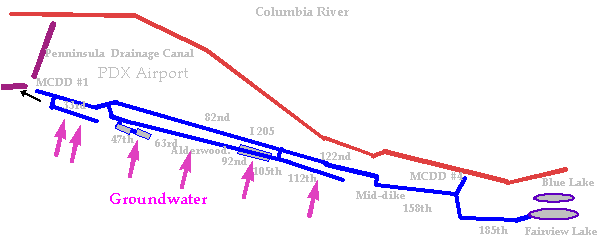
W
ater quality problems in the Slough affect how fish
and aquatic life and we use the resource. Table 1 shows a list
of water quality problems in the Columbia Slough along with potential
sources of pollution.
Table 1. Water quality problems in the
Columbia Slough.
| Water quality problem | Potential sources of problem | Description of impact - why is this of concern ? |
| pHpH levels above 8.5 | excessive algal growth due to high nutrient levels of N and P; these nutrients could be coming from groundwater in the Upper Slough, St. John's LandfillSt. John's Landfill leachate, CSOCSOs, and stormwater inflows | High pHpH levels create a poor environment for fish and aquatic life; a summer problem |
| dissolved oxygendissolved oxygen levels below 4 mg/l | high organic loading from PDX International Airport's winter deicing activities, CSOCSOs, storm water, sediment oxygen demand, and groundwater | all fish and aerobic organisms require oxygen to live in the water environment, water deprived of oxygen will cause aerobic organisms to die or relocate, a summer and winter problem |
| algaealgae levels above 15 g/l chlorophyll a | excessive algal nutrients, N and P from groundwater and St. John's LandfillSt. John's Landfill leachate, CSOCSOs, and stormwater inflows | high algaealgae levels create high pHpH levels (see above) and create nuisance, aesthetic concerns by forming algal mats on the surface of the water, reducing water clarity (water looks muddy) and contributing to sediment oxygen demand by the settling of dead algal cells to the bottom muds, a summer problem |
| coliform bacteriabacteria levels above 200 colonies/100 ml | CSOCSOs and storm water inflows, as well as illicit sewer discharges | coliform bacteriabacteria themselves are harmless and exist in our intestines, but they indicate that there is some fecal contamination in the water - either from human or animal waste, a summer and winter problem |
| high water temperaturetemperatures | lack of shading and impounding water, lack of natural water level fluctuation | to support cold water fish such as Salmon, temperaturetemperatures of 14oC (52.7oF) are an optimal upper limit, this is only a summer issue |
| toxic metals and organics in sediments, water column, and fish tissue | unregulated and illegal discharges into the Slough, storm water and CSOCSO discharges, landfill leachate | Toxic compounds can be consumed by fish and other aquatic life that bioaccumulate the toxins in their tissue. This becomes a health hazard when humans consume the contaminated tissue and a health hazard to aquatic organisms. |
Where does the water come form
in the Upper and Lower Columbia Slough ? The source of the water
quality problems in the Slough can be traced to inflows to the
system or historical activity in the area, such as building dikes
and installing culverts.
For example, what causes the high algae growth in the Slough in the summer months ? Excessive nutrients for algae growth - such as nitrogen (ammonia, NH3-N, nitrate, NO3-N) and phosphorus compounds (orthophosphate, PO4-P), sunlight, and detention time in the system (the time a parcel of water stays in the Upper or Lower Slough before exiting into another water body) allowing enough time for algal growth. What is the source of the nutrients ? In the Upper Slough, the only significant source of water inflow during the summer is groundwater (this usually averages between 50 and 80 cfs). The groundwater comes from E. Multnomah County and contains high concentrations of nitrate (about 6 mg/l) and orthophosphorus (about 0.1 mg/l). Phosphorus limits algae growth since nitrogen is in such. Figure 3 shows the inflows (the relative volume of water over the summer period) from different sources during the summer of 1992 for the Upper Slough. (The Boeing source is water from a groundwater pump-and-treat system that discharges to the Upper Columbia Slough. There was no inflow from Fairview Lake in 1992 except leakage through a weir.) To show the source of orthophosphorus which causes excessive algae growth, Figure 4 shows which sources are the primary contributors for orthophoshorus. These figures show clearly that groundwater is the primary source of phosphorus during the summer months.

What about in the Lower Slough ? Figures 5 and 6 show the distribution of inflows and orthophosphorus mass loading to the Lower Slough during the summer of 1992. These show that the Upper Slough contributes most of the flow into the Lower Slough in the summer. Hence, inflows from the Upper Slough are the primary source of phosphorus for the Lower Slough in the summer.
Low dissolved oxygen concentrations
have been recorded in the summer near MCDD4. This
was a result of stagnant water conditions when the mid-dike levee
was closed and little or no pumping was made at MCDD4 into the
Columbia River. The decaying algae
in the water caused low dissolved oxygen conditions. The dead
algae settle into the sediment and decay. The bacteria
and zooplankton consume algae and oxygen, thus depleting the water
if oxygen for fish and other aquatic life.
In the winter, low and zero dissolved oxygen
has been recorded in the Slough system after warm rains following
very cold conditions. The low dissolved oxygen is caused by bacterial
breakdown of biodegradable organic material or of ammonia compounds.
Sources of these compounds are storm water, CSOs, sediment
accumulation from summer algae decomposition, urea
(a deicier applied to the airport and to roads and bridges during
freezing conditions, this compound readily breaks down to ammonia),
and deicing chemicals from the Portland International Airport
applied to airplanes to prevent ice formation on wings. These
deicing compounds are called ethylene and propylene glycols and
have an organic strength (when not diluted with water) over 10,000
times that of CSOs and storm water.
All storm water runoff from the PDX International
Airport either infiltrates into the groundwater or runs off into
the Upper Columbia Slough. During periods of CSO and
storm water inflows when there were no antecedent cold weather
conditions (when the airport would not usually be deicing aircraft),
dissolved oxygen conditions in the winter
were not below DEQ minimum standards of 4 mg/l. But following
cold weather conditions (when aircraft and runway deicing were
being used) and a warm rain (washing the deicing material into
the Upper Slough), dissolved oxygen concentrations in the Slough
often dipped below 4 mg/l. In an estimate of the loading of BOD
(a measure of the biodegradable organics in the water), Figure
7 and 8 show the estimated loadings from storm water, the airport,
and CSOs for the Upper and Lower Slough, respectively. [These
estimates were made
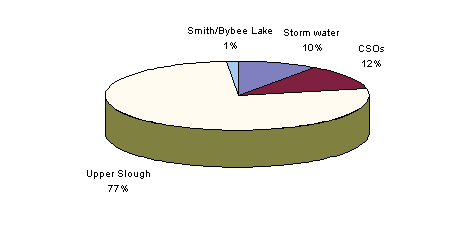
by using a model of the system to reproduce water
quality data in the Slough and not from measurements.]
In these figures, the Upper Slough predominant source
of biodegradable organics is the PDX Airport during periods following
deicing of aircraft. In the Lower Slough, the primary source is
the Upper Slough discharge.
Figure 9 shows measurements of dissolved oxygen in
the Lower Slough and meteorological data before and during a low
dissolved oxygen event during 1996. The discharge of high BOD
waste, such as deicing materials, is acerbated by increases in
the stage of the Willamette River because the Lower Columbia Slough
stagnates (see Wells, et al., 1996).
During summer and winter rain events, the Portland
sewage treatment plant cannot take all the water from sanitary
and storm water and some spills untreated into the Columbia Slough
as a combined sewer overflow (CSO). The bacteria
loading from CSOs is the primary source of pathogenic bacteria
in the Lower Slough in the summer and winter. In the Upper Slough,
storm water and unknown sources contribute to coliform levels
above the standard of 200 colonies/100 ml sample, but these violations
are usually small compared to the CSOs which contribute bacteria
concentrations usually greater than 100,000 colonies per 100 ml
sample.
Temperatures above the optimum range for Salmon are
caused by pooling of water in the Upper Slough and removal of
shade trees along the banks of the Slough system. The optimum
upper temperature for cold water fish such as
Salmon is about 14oC (52.7oF), with an upper
lethal temperature of 26oC (78.8oF). In
the Upper Slough and Lower Slough, temperatures above 25oC
(77oF) are common. Other fish species, such as warm
water fish like crappie, bass, enjoy the warmer waters. For example,
the impoundment of Smith and Bybee Lake in 1982 had led to increases
in water temperatures such that warm water fish now reside in
those lakes.
Toxic compounds have been found in some sediment
locations in the Lower and Upper Slough, as well as in fish tissue.
These compounds can impact human health when
Currently, a separate study by the City of Portland
is underway to determine how significant a problem toxics are
and what level of caution the public should exercise. The source
of these toxics is industrial discharges and storm water.
Solving water quality problems
involves (i) cutting off the source of the problem and (ii) managing
the system to minimize the impact of the problem if source control
is not possible. Sometimes a combination of the two approaches
is the most cost-effective.
In 1989 an environmental study of methods to improve
water quality in the Slough for the City of Portland recommended
flow augmentation of Columbia River
water into the Lower Slough at the end of the Peninsula Drainage
Canal or at MCDD4 in the Upper Slough. Figure 10 shows
how this alternative would work. The goal was to reduce the impact
of CSOs by diluting the CSO inflow with Columbia River
water and to reduce algae concentrations by reducing
the detention time of algae in the Lower Slough. If the inflows
were to be directed through the Upper Slough they could also,
it was thought, reduce algae growth in both the Upper and Lower
Slough. The estimated capital costs were thought to be between
$6,000,000 and $8,500,000, depending on whether the location was
through the Peninsula canal or through the
Upper Slough at MCDD4. This first study though did not anticipate
the higher costs associated with this proposal because of fish
passage, flood control, and pipe size problems. Later studies
showed that the algae growth problem would not be solved with
flow augmentation as it was proposed and that bacteria
standards for CSOs could not be met. Hence, the City decided on
another approach for CSO control - construction of wet-weather
storage facilities to contain most events rather than discharging
directly into the Slough. This construction project will be completed
by the year 2001.
Reducing the groundwater inflow to the Upper Slough
was not a feasible solution either. The most practical solution
appeared to be lowering water levels in the Upper Slough by pumping
out the groundwater - in essence, flow augmentation
with groundwater. The idea behind this suggestion was to reduce
the residence time of water in the Upper Slough to cut down the
possible time for algae growth. This strategy has
been tried over the last few summers with some encouraging results
(see Section 7).
Figure 10. Flow augmentation alternative
through Peninsula Canal or through Upper Slough at MCDD4MCDD4.
In order to reduce the trial
and error approach to managing the complex Columbia Slough system,
a mathematical model of the Columbia Slough system was developed
at PSU to help the City, METRO, and other local and
State agencies interested in the Slough to evaluate potential
management strategies. This model is a computer code that predicts
flow in and out of the Slough and water quality changes occurring
within the Slough. The model allows water quality managers and
interested citizens to estimate the impact of a particular management
strategy on the Slough and ask hypothetical questions, such as:
The benefit of such a model is to eliminate alternatives
that would not solve the Slough's water quality problems and to
focus on those that will have a strong benefit to the system.
What, though, is a water quality model ? What can
a water quality model do and not do ?
In order to explore methods to
improve water quality in the Columbia Slough system, several studies
have been sponsored by the City of Portland, Bureau of Environmental
Services. These studies
were undertaken to assess the current state of water quality in
the system and to develop a computer model of the Slough system.
The steps in development of a computer model are
What is the model ?
The "model" is a set of computer instructions
written in a computer language (FORTRAN) describing the physics,
biology, and chemistry of the Lower and Upper Slough. This model
predicts the water quality and hydraulic parameters shown in Table
2 as a function of time, vertical and longitudinal location.
Table 2. Water quality variables simulated
in the Slough model.
| Water quality or hydraulic variable simulated in the Upper and Lower Slough model | Importance of variable in assessing water quality conditions |
| water surface elevation | affects direction of water movement |
| water velocity | water movement or water velocity tells us where the water moves and how fast |
| temperaturetemperature | important for fish survival and affects all biological and chemical processes, affected by meteorological conditions (including shading) |
| algaealgae concentration | the model predicts algaealgae biomass concentrations, telling us where the algae growth problems are and at what concentration nuisance conditions are encountered |
| bacteriabacteria | coliform bacteriabacteria are modeled in the Slough, these are indicators of pathogenic organisms |
| pHpH | if pHpH is below 6.5 or above 8.5 fish and aquatic life could be impaired |
| dissolved organic matter (soluble) | a measure of the amount of biodegradable organics in the water; as bacteriabacteria consume this organic matter, oxygen is consumed; this is comparable to BOD (biochemical oxygen demand, which is a measure of the amount of oxygen required to biodegrade an organic waste) |
| refractory organic matter (soluble) | same as dissolved organic matter except that the rate of decay of these organics is very slow |
| sediment organic matter | determines the rate of oxygen consumption by particulate matter settled to the bottom of the Slough - typically dead algaealgae and particulate organics coming into the Slough |
| detritus (particulate organic matter) | Particulate organic matter that decays as bacteriabacteria consume detritus as food, an oxygen sink |
| total inorganic carbon | this is all the non-biological (inorganic) carbon in the system, these components are affected by algaealgae growth and gas transfer across the air water interface, these components affect pHpH |
| alkalinity | a measure of the water's ability to neutralize acids, affects pHpH |
| dissolved oxygendissolved oxygen | amount of oxygen in the water; important for fish and aquatic life |
| soluble phosphate | amount of dissolved phosphorus in the water; an algaealgae nutrient |
| nitrate | amount of dissolved nitrate in the water; an algaealgae nutrient |
| ammonia | amount of dissolved ammonia in the water; an algaealgae nutrient and a chemical that consumes oxygen |
| zooplankton | an organism that consumes algaealgae and detritus, fed on by fish, consumes oxygen and reduces algae |
| conservative tracer | amount of a conservative, or non-biodegradable, material in the water |
The ability of the model to predict water movement
and quality is dependent on the quality of input data available
for the model. When the water quality model does not predict water
quality conditions well, that means the following could be true:
Generally, the model can predict the parameters in
Table 2 throughout the Slough system when good input data to the
Slough are known. These model input data include
The model then is only as good as the input data
given to it. In some cases other models have to be used to estimate
some of the boundary condition data. For example, the storm water
and CSO flows into the Upper and Lower Slough have been
modeled for flow and quality. Why ? Because we would have to continuously
sample almost 50 locations in the Upper and Lower Slough to obtain
the data required for the model. These sampling locations would
be the outlet pipes as the discharge enters the system. Hence,
the approach used was to take measurements at a few locations
so that the storm water and CSO models could be calibrated. This
means that the storm water and CSO models well represented the
measurements. Then those models were used as inflows to the Slough
system model at other locations and times.
A weakness in the present model is that Willamette
River water quality is measured only every
other week in the summer. The Willamette River inflows into the
Columbia Slough and causes changes in water quality of the Lower
Slough. To reproduce water quality data in the Lower Slough better,
continuous water quality data would be required.
The model has been calibrated to both low water and
high water hydraulic conditions. But the model is not suited to
simulate the flood of 1996 unless further information of the channel
shape above 14 ft MSL were known (14 ft MSL is the current "top"
of the model). The 1996 flood had water levels above 25 ft MSL.
The model currently includes the domain from Lombard
Street bridge in the Lower Slough to the western side of Fairview
Lake in the Upper Slough. This is shown in Figure 11. The model
includes all "sections" of the Lower (such as North
Slough, Smith and Bybee Lakes) and Upper Slough (Whitaker Slough,
Buffalo Slough, etc.), including the Peninsula Drainage Canal.
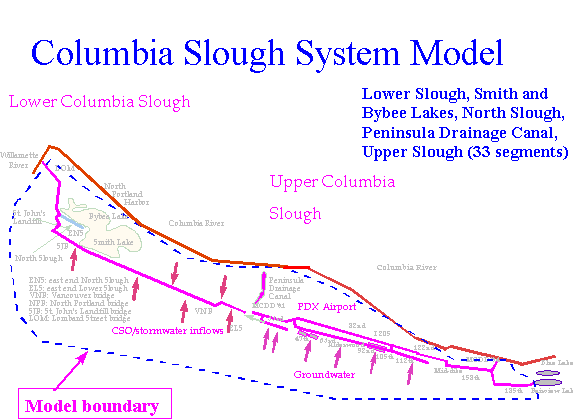
In general, in the Lower Slough the model has predicted
water surface elevations and flow rates within 10% of the daily
variation.
The water surface in the Upper Slough during a pump
test well illustrated the model's ability to predict the "water
hammer" effect when the pumping rate at MCDD1
was changed. Note Figure 12 which shows water surface elevations
at MCDD1 in the Upper Slough during the summer of 1993. On Julian
day 278 the pumps at MCDD1 were turned off and the water level
rose. Then on Julian day 281, the pumps were started and the water
level dropped. There were small increases in water level as MCDD1
pumping rates were reduced. The model correctly mimicked the physics
of the "water hammer".

Water surface elevations are well reproduced in the
Upper Slough also when enough data are available to know the inflow
rates. Figure 13 shows predicted flow rates at NE 47th
in the Southern arm of the Upper Columbia Slough compared to field
data taken at the same location.
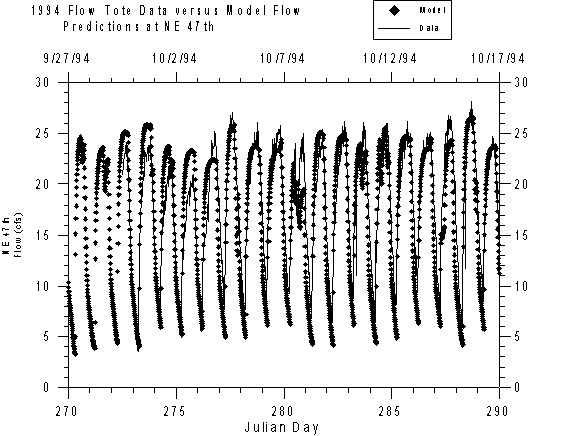
The model predictions in the summer and winter have
generally been good. Figure 14 shows a comparison of model predictions
and measurements in the Upper Slough at NE 47th on
the Southern arm for dissolved oxygen,
pH, and temperature for 1993. Figure
15 shows model predictions of dissolved oxygen, temperature, and
pH during a winter flood event in 1995 at St. John's Landfill
bridge in the Lower Slough. The model typically predicts temperature
within 1oC, dissolved oxygen within 1-2 mg/l, and pH
within less than a pH unit.
When boundary conditions data were not available,
the model predictions were not good. For example, coliform bacteria
were at concentrations close to 500 to 600 colonies per 100 ml
at one station in the Upper Slough near NE 138th. The
model though predicted no coliform bacteria because no source
of bacteria was known for the model input. Hence, the model can
only predict in-stream water quality well if the boundary conditions
are known.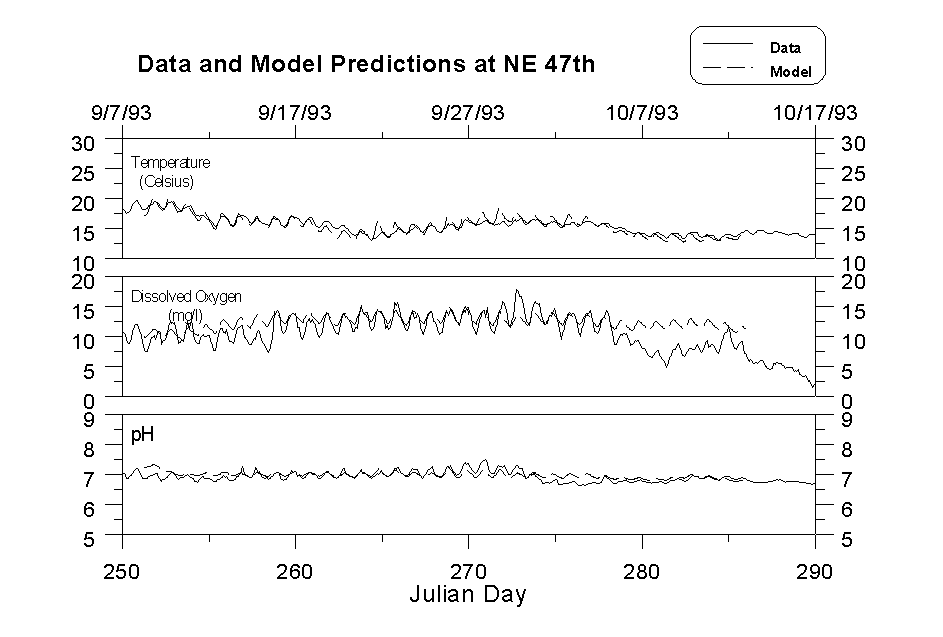
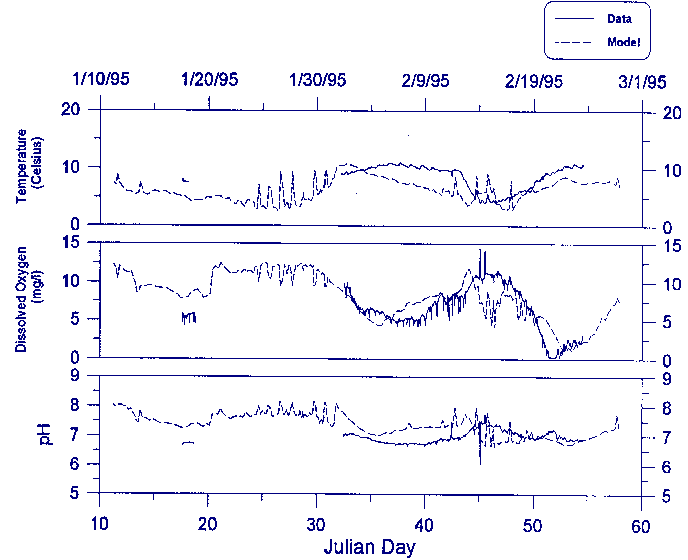
Figure 15. Winter 1995 model
predictions compared to field data at St. John's Landfill bridge.
As the model calibration is improved, management
scenarios are simulated with the model. Over the last 5 years,
dozens and dozens of management scenarios were evaluated with
the Slough models. A representative list of some of these model
scenarios is shown in Table 3. Figures 16 through 24 show graphically
some of these management scenarios.
Table 3. Representative model scenarios
simulated with Columbia Slough model.
| Management Strategy | Why Was This Strategy Considered ? |
| Flow augmentation from Columbia RiverColumbia River | flow augmentationflow augmentation is a method to increase the flow rate of water in the Slough to dilute bacteriabacteria and to reduce the detention time of water to reduce algaealgae growth, the Columbia RiverColumbia River water was chosen since it was considered relatively "clean" |
| Tree shading in Upper Slough | Reduce the penetration of sunlight to the Slough, thereby reducing water temperaturetemperatures |
| Flow augmentation in Upper Slough from groundwater | reduce detention time of water in the Slough to reduce the growth of algaealgae, also to lower the temperaturetemperature of Upper Slough water |
| CSOCSO removal | eliminate pathogenic bacteriabacteria from untreated sewage |
| Changes in culvert sizes in Upper Slough in conjunction with low-flow test | allow isolated channels in the Upper Slough to become more hydraulically connected to the Upper Slough, this would allow flow augmentationflow augmentation with groundwater to be more successful since the residence time of water in the Slough could then be reduced |
| Efficiency of wetland treatment in Upper Slough | decrease nutrients and algaealgae biomass in Slough |
| Storm water treatment | decrease nutrients entering the Slough |
| Reduce airport discharge of deicing chemicals in the winter | decrease BOD load from deicing chemicals which lower dissolved oxygendissolved oxygen |
| Removal of barge from North Slough | increase tidal flushing into North Slough |
| Opening up Smith and Bybee Lakes to North Slough | increase tidal flushing in North Slough and allow Smith and Bybee Lakes to experience full tidal flushing |
| Opening up Peninsula Drainage Canal to Columbia RiverColumbia River and Columbia Slough | allow discharges from CSOCSOs and from the Upper Slough to short-circuit to the Columbia RiverColumbia River, enhance flow in East end of Lower Columbia Slough |


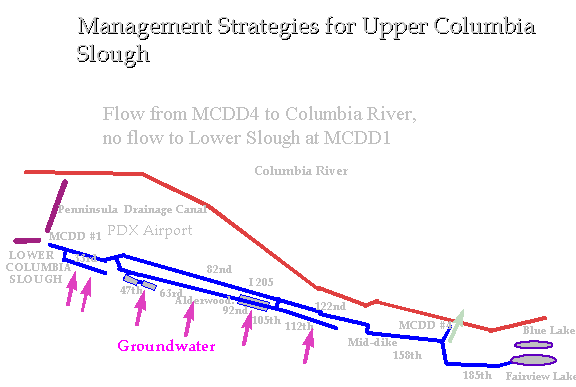

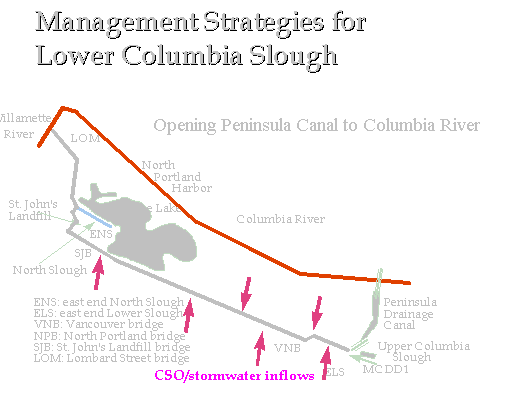

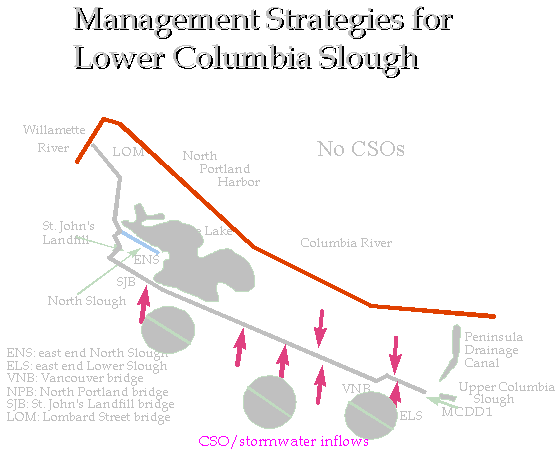
The following general conclusions were made (specific
details, such as information as to how great an improvement or
how small the improvement was, are itemized in technical reports
shown in the References section):
In 1993 the City of Portland in cooperation with
MCDD1 and PSU began a flow augmentation
strategy using groundwater. The idea was to reduce the detention
time in the Upper Slough so that algae would not have
time to grow. In addition, a larger culvert was added at Prison
Pond at 112th to reduce water levels further. The lower
the water levels in the system, the shorter the detention time
in the Slough. During this period, the mid-dike levee was closed
to provide irrigation water to those on the East side of the mid-dike.
Figure 25 shows a comparison of chlorophyll a concentrations
in the Upper and Lower Slough between 1992 and 1995. Algae concentrations
decreased starting in 1993 and were less than 15 g/l in 1995.
Figure 26 also shows the dissolved phosphorus in the Upper Slough
for 1995. This figure shows that the Northern arm of the Upper
Slough was below 0.02 mg/l as P.
What is responsible for this reduction in algae growth
? The lower water levels in the Upper Slough reduced suspended
algae concentrations by reducing the detention time of the water
in the Upper Slough. This has caused a gradual build up of rooted
aquatic plants, macrophytes in the Upper Slough since light now
was able to penetrate to the bottom of the channel. The macrophytes
take nutrients generally from the sediment. But other plants use
the macrophytes as a substrate or a base on which they live. These
other plants are probably taking up nutrients from the water column.
This increase in macrophyte growth has then lead to a significant
reduction in dissolved orthophoshorus, resulting in a significant
lowering of chlorophyll a levels in 1995.
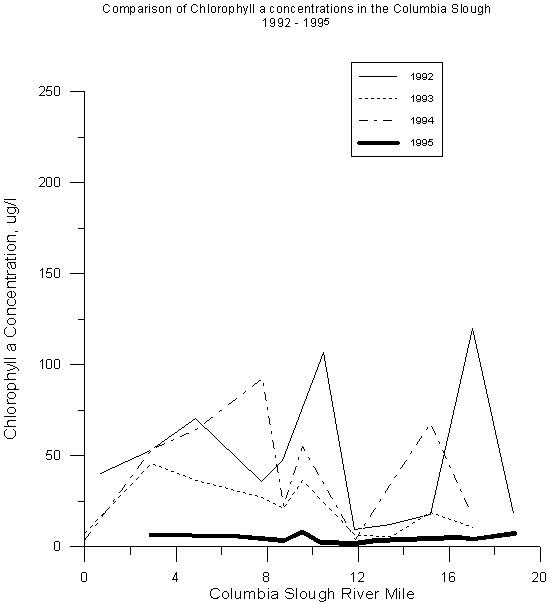
Figure 26. Summer average
PO4-P in the Upper Slough in 1995.
To illustrate the changes in average pH
(pH provides an indication of algal growth in the Slough for comparable
weather and nutrient conditions) over the years, Figure 26 shows
the decrease in pH by about 1 pH unit (a factor of 10 decrease)
from 1992 to 1995.
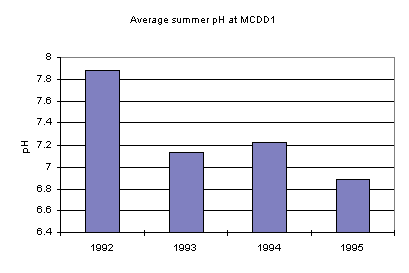
The Slough system model is being refined further
by improving the following algorithms and input data:
In addition to these improvements noted above, PSU
is simulating some new scenarios for water quality and aquatic
health improvement in the Columbia Slough system. These scenarios
are focused on long-term management of the Slough system when
the need for irrigation water from the Upper Slough diminishes.
These additional modeling scenarios (some of which are illustrated
in Figures 15-23) include the following items:
These scenarios are intended to evaluate the effects
of re-opening up the Slough system to the Columbia River.
Historically, the Upper Slough was kept separate to provide water
for irrigation in the summer and for flood control. With the diminishing
use of the irrigation water, these simulations will assess the
utility of allowing the Upper Slough to respond to tidal fluctuations
in the Columbia River (either through the Peninsula Drainage Canal
or Lower Slough). Gated pipes were thought to be necessary for
these simulations to continue the flood protection value of the
systems.
The re-connection of these systems to the Columbia
River should have both water quality and
habitat restoration value for the Columbia Slough. The computer
simulations will help water managers to assess which alternatives
are the most valuable and how those alternatives can be designed
and implemented.
The following reports provide
information on which this report was based:
Bard, H. (1994) "Relationship
of Deicing Fluids to Low Dissolved Oxygen Levels in the Upper
Columbia Slough, Portland, Oregon," Research report for City
of Portland and Port of Portland, Portland, Oregon.
Brown and Caldwell (1989) "Columbia Slough Planning
Study - Water Quality Management Alternative Evaluation,"
submitted to City of Portland, Bureau of Environmental ServicesBureau
of Environmental Services, Portland, Oregon.
Bureau of Environmental ServicesBureau
of Environmental Services (1989) "Columbia
Slough Planning Study Background Report," City of Portland,
Portland, Oregon.
CH2MHill (1995) "TMDL Study of the Columbia
Slough," submitted to the City of Portland, Bureau of Environmental
ServicesBureau of Environmental
Services, Portland,. Oregon.
Cole, T. and Buchak, E. (1994) "CE-QUAL-W2 User's
Manual," Corps of Engineers, Waterways Experiments Station,
Vicksburg, Ms.
Collins, D. and Wells, S. A. (1992) "St. John's
Landfill and Columbia Slough System Water Quality Database,"
Technical Report EWR-02 Department of Civil Engineering, Portland
State University, Portland, Oregon.
Corps of Engineers (1986) "CE-QUAL-W2: A Numerical
Two-Dimensional, Laterally Averaged Model of Hydrodynamics and
Water Quality: User's Manual," Environmental and Hydraulics
Laboratory, Waterways Experiments Station, Vicksburg, Mississippi.
Corps of Engineers (1990) "DRAFT - Updated CE-QUAL-W2
User's Manual," Waterways Experiment Station, Vicksburg,
Mississippi.
Corps of Engineers (1993) "Feasibility Report
for Flow Augmentation in the Columbia Slough," Portland District,
Portland, Oregon.
Fetter, C. W. (1993) Contaminant Hydrogeology,
MacMillan Publishing Company, New York.
Hayford, Tim (1993) Personal communication, Manager,
MCDD#1, Portland, Oregon.
HDR, Engineering (1993) "Columbia Slough Implementation
Report - Phase II," Portland, Oregon.
Mericas, D. and Wagoner, B. (1994) "Balancing
Safety and the Environment," Water Environment and Technology,
6 (12), 38-43.
Metcalf and Eddy (1991) Wastewater Engineering,
McGraw-Hill, New York.
Juza, H. (1993) Letter report on Lower Columbia Slough
modeling results using SWMM, City of Portland, Bureau of Environmental
ServicesBureau of Environmental
Services, Portland, Oregon.
OTAK, Inc. (1993) Letter Report on Lower Columbia
Slough CSOCSO
Loadings, Lake Oswego, Oregon.
SRI/Shapiro (1994) Assessment of Algae and Rooted
Aquatic Plant Responses to Summer 1994 Columbia Slough Draw-Down,
submitted to CH2MHill, Portland, Or.
Tchobanoglous, G. and Schroeder, E. (1987) Water
Quality: Characteristics, Modeling, Modification, Addison-Wesley,
Reading, Ma.
Thomann, R. and Mueller, J. (1987) Principles
of Surface Water Quality Modeling and Control, Harper and
Row, New York.
Wells, S. A. (1992a) "Assessment of Management
Alternatives for Water Quality Improvement in the Columbia Slough
System," Volumes 1 and 2, Technical Report EWR-01-92, Department
of Civil Engineering, Portland State University, Portland, Oregon.
Wells, S. A. (1992b) "Columbia Slough System
Field Data Summaries 1990 and 1991," Technical Report EWR-02-92,
Department of Civil Engineering, Portland State University, Portland,
Oregon.
Wells, S. A. (1992c) "Analysis of Strategies
for Improving Water Quality in North Slough Adjacent to the St.
John's Landfill," Technical Report EWR-08-92, Department
of Civil Engineering, Portland State University, Portland, Oregon.
Wells, S. A. (1993) "Upper and Lower Columbia
Slough Field Data Summaries from July 1992 through December 1992:
Continuous and Synoptic Hydrolab and Continuous Gaging Station
Data," Technical Report submitted to HDR Engineering and
City of Portland, 60 pages.
Wells, S. A. and Berger, C., and Staats, M. (1993)
Hydraulic and Water Quality Modeling of the Upper Columbia Slough:
Model Description, Geometry, and Forcing Data," Technical
Report submitted to HDR Engineering and City of Portland, 121
pages.
Wells, S. A. and Berger, C. (1993) Hydraulic and
Water Quality Modeling of the Upper and Lower Columbia Slough:
Model Calibration, Verification, and Management Alternatives Report,"
Technical Report submitted to HDR Engineering and City of Portland,
202 pages.
Wells, S. A. and Berger, C. (1994) "Upper and
Lower Columbia Slough Water Level Test: September 1 through October
29, 1993," Technical Report EWR-2-94, Department of Civil
Engineering, Portland State University, Portland, Oregon.
Wells, S. A. (1995) "Analysis of Flow Augmentation
from Smith and Bybee Lakes on North Slough Dissolved Oxygen Conditions,"
Technical Report EWR-01-95, Department of Civil Engineering, Portland
State University, Portland, Oregon.
Wells, S. A.; Berger, C. J., Abrams,
M. (1996) "Winter Storm Event Impacts on Dissolved Oxygen
Levels in the Columbia Slough System," Proceedings Second
Annual Pacific Northwest Water Issues Conference: The Flood of
1996, October 7,8, Portland, Oregon.
Woodward-Clyde Consulting Engineers (1993) Storm
water and groundwater water quality sampling results, Letter report
to HDR Engineering, Mike Fowler and Eric Strecker, August, 1993,
Portland, Oregon.
Algae: small plant that is transported by the
water and that settles.
CSOs: combined sewer overflows; these are
combined storm and sanitary sewers built decades ago; hence rainwater
and raw sewage are combined and treated at the Columbia Blvd.
treatment plant by the City, but during periods of high-rain,
often only as little as a 0.1 inch in an hour, the treatment plant
becomes overloaded and combined sewers discharge into the Columbia
Slough. The largest is located at NE 13th St.
Macrophyte: rooted aquatic plant
MCDD1: Multnomah County Drainage District
1; a drainage district with headquarters at the wets end of the
Upper Slough. Staff currently manage the Upper Slough, the culverts
connecting Fairview Lake to the Upper Slough, and some of the
Peninsula Pump Station Districts along the Lower Slough.
MCDD4: Multnomah County Drainage District
pump station 4 located at Marine Drive near the Columbia River.
This pump station sends water from the Upper Slough to the Columbia
River.
Storm water discharges: rainwater from the streets,
parking lots, roof drains, etc. are collected and routed to the
Columbia Slough through pipes.
Zooplankton: small animal which eats algae, bacteria,
and other solid organic matter.
Aalgae · 6, 7, 9, 13, 15, 17, 24, 30, 31Bbacteria · 6, 9, 12, 13, 17, 21, 24, 30Bureau of Environmental Services · 0, 3, 16, 36CColumbia River · 2, 4, 9, 10, 13, 24, 27, 30, 34, 35, 38CSO · 2, 4, 6, 9, 12, 13, 15, 18, 24, 29, 30, 36, 38CSOs · 4Ddissolved oxygen · 2, 6, 9, 11, 17, 21, 24, 30FFairview Lake · 4flow augmentation · 2, 13, 24, 25, 27, 30, 31Mmacrophyte · 34MCDD1 · 2, 3, 4, 15, 18, 19, 31, 33, 34, 38MCDD4 · 2, 4, 9, 10, 13, 14, 18, 26, 27, 30, 34, 38METRO · 3, 15PPeninsula canal · 13pH · 2, 6, 17, 21, 33Portland International Airport · 4, 9, 30SSmith and Bybee Lake · 34Smith and Bybee Lakes · 4St. John's Landfill · 4, 6, 18, 21storm water · 4Ttemperature · 2, 6, 11, 12, 17, 18, 21, 24, 30WWillamette River · 4, 18